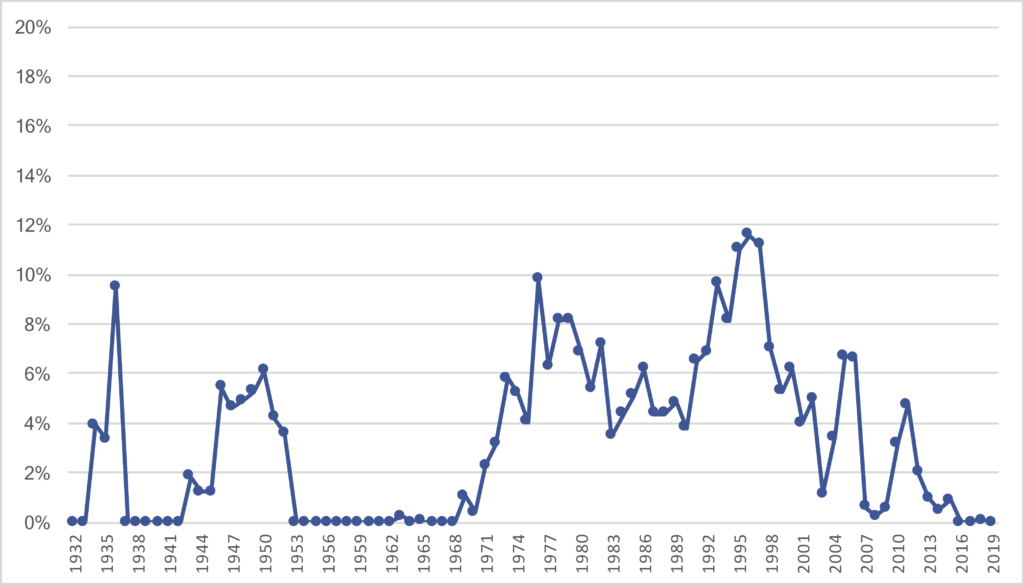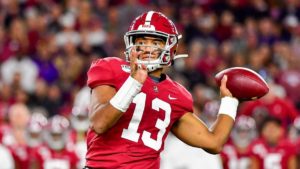In a few weeks, Alabama quarterback Tua Tagovailoa will be drafted early in the first round of the 2020 NFL Draft. In doing so, he will become the fourth Crimson Tide passer to get drafted in the first round (in addition to Hall of Famers Bart Starr and Ken Stabler, who were not first round picks). But in the current, golden era of Alabama football, this isn’t much of a surprise: in fact, his former teammate, QB Jalen Hurts, will also hear his name announced during this draft.
Being born in Hawaii and of Samoan descent makes Tagovailoa a rarity in NFL circles, but not unique: he will join Marcus Mariota as the second such quarterback in the NFL.
But there is something particularly distinct about Tua: he throws the football with his left hand. The last quarterback in the NFL who was lefthanded was Kellen Moore, who went undrafted eight years ago in 2012 and has not thrown a pass in the NFL since 2015 (and, of course, is now the offensive coordinator for the Cowboys). The last southpaw quarterback to get drafted in the first round was Tim Tebow.
Over the last decade, the lefty has disappeared from the NFL passing landscape. Sure, you get the occasional lefthanded pass from a Tyreek Hill, Kevin Byard, or Antonio Brown, and the even rarer lefthanded toss by a righty, but the last time a lefthanded quarterback back stated and won a game was Michael Vick back in week 6 of the 2015 season! As I wrote last year, the lefthanded quarterback has been slowly phased out of the game; the graph below shows the percentage of passing yards in each season since 1932 that were thrown by southpaws:
 The peak came in the mid-’90s, when Steve Young, Boomer Esiason, Mark Brunell, and Scott Mitchell were all starters. In the 2019 season, not a single pass was thrown by a leftie. There have not been many lefthanded quarterbacks to make it to the NFL, and even fewer great ones. The best of the bunch are Young, Esiason, Brunell, Frankie Albert, Vick, Jim Zorn, and a man mentioned at the start of this article — Ken Stabler. After that, you’ve got guys like Mitchell, Bobby Douglass, and Tim Tebow and … that’s pretty much it. To the extent you know another one, it’s probably a first round bust (Terry Baker, Ernie Case, Matt Leinart, Cade McNown, or Todd Marinovich), a college superstar (like Paul McDonald or Pat White), or famous because of a nickname (Jared Lorenzen) or their father (Chris Simms).
The peak came in the mid-’90s, when Steve Young, Boomer Esiason, Mark Brunell, and Scott Mitchell were all starters. In the 2019 season, not a single pass was thrown by a leftie. There have not been many lefthanded quarterbacks to make it to the NFL, and even fewer great ones. The best of the bunch are Young, Esiason, Brunell, Frankie Albert, Vick, Jim Zorn, and a man mentioned at the start of this article — Ken Stabler. After that, you’ve got guys like Mitchell, Bobby Douglass, and Tim Tebow and … that’s pretty much it. To the extent you know another one, it’s probably a first round bust (Terry Baker, Ernie Case, Matt Leinart, Cade McNown, or Todd Marinovich), a college superstar (like Paul McDonald or Pat White), or famous because of a nickname (Jared Lorenzen) or their father (Chris Simms).
But there’s no question that the game is better off when the league is more diverse, and having a lefthanded quarterback is a good thing. There are trickle down effects to consider: Harris Barton became famous as the right tackle protecting Young’s blindside in San Francisco; on the other hand, it made guys all-time great left tackles like Art Shell and Tony Boselli protecting the frontside of their quarterbacks. And having a lefthanded quarterback can lead to all sorts of innovation, whether it’s the run-heavy styles we saw from Tebow or Douglass or Vick, or the groundbreaking work of one of the game’s first southpaws.
In 1940, Stanford went undefeated and won the Rose Bowl under legendary head coach Clark Shaughnessy. That Stanford team was the one that made famous the T-formation, drawn up by Shaughnessy that year with his young quarterback: lefthanded Frankie Albert. It was the T-formation that Shaughnessy helped the Bears install to defeat Washington in the title game in the biggest blowout in NFL history. And after another great season in 1941, Albert would go on to get drafted by those same Bears in the first round of the 1942 Draft. Of course, Frankie Albert would never play for Chicago: after serving in the Navy during World War II, he would go on to join the San Francisco 49ers in the AAFC and later the NFL.
But in addition to the T-formation, Albert is famous for one other innovation in football: he helped popularize and perfect the bootleg. As a left-hander, Albert would have a natural advantage on play action plays running to the offense’s right or strong side: if he could trick defenses into thinking he had handed the football to a back, the lefthander would be in a position to quickly throw or run with the football. Albert was a great quarterback and overall football player, who rushed for 27 touchdowns in his short career, including 8 in 1948. The game is better when there are different playing styles involved, and nowhere is that more true than at quarterback. When Tua’s name is called on draft day, it will end the longest streak in modern pro football where the NFL has not had a southpaw passer.

